CCNA is the entrance level certification for entry level network engineers. CCNA lessons covers all the entrance level networking levels that a network engineer need. According to the technology trends, certification content is being updated always. Here, we will cover the latest minor update in CCNA Exam, CCNA 200-301 v1.1. We will learn what is new in this updated CCNA Certification and course. What are CCNA lessons v1.1? We will also list all Cisco Certified Network Associate lessons that you should learn to be successful in Cisco CCNA 200-301 Exam.
The latest major update was at 24 February 2020. At that time, many of CCNA lessons has updated, some of them has removed and new lessons have added. This was a major update of Cisco CCNA Exam. Here, we will focus on a minor update, update from CCNA v1.0 to v1.1. Here, not many of the lessons but a few of them is changed with few additions. Beside new lessons that cover, new networking technology trends has added.
So, what is new in updated CCNA Certification? Let’s see these minor updated on Cisco ‘s most popular network certification, Cisco Certified Network Associate.
Table of Contents
What is new in Updated CCNA 200-301 v1.1? | CCNA Lessons v1.1
As we have mentioned above, the latest update is a minor update. An update from CCNA v1.0 to CCNA v1.1. With this update, some of the lessons will be removed, some of them will be added. Beside key technology trends lessons will be added. The new technology trend lessons in CCNA 200-301 v1.1 are Generative AI (Artificial Intelligence), Cloud Network Management and Machine Learning. So, what are these changes, removed, updated and new CCNA lessons v1.1? Let’s check them one by one.
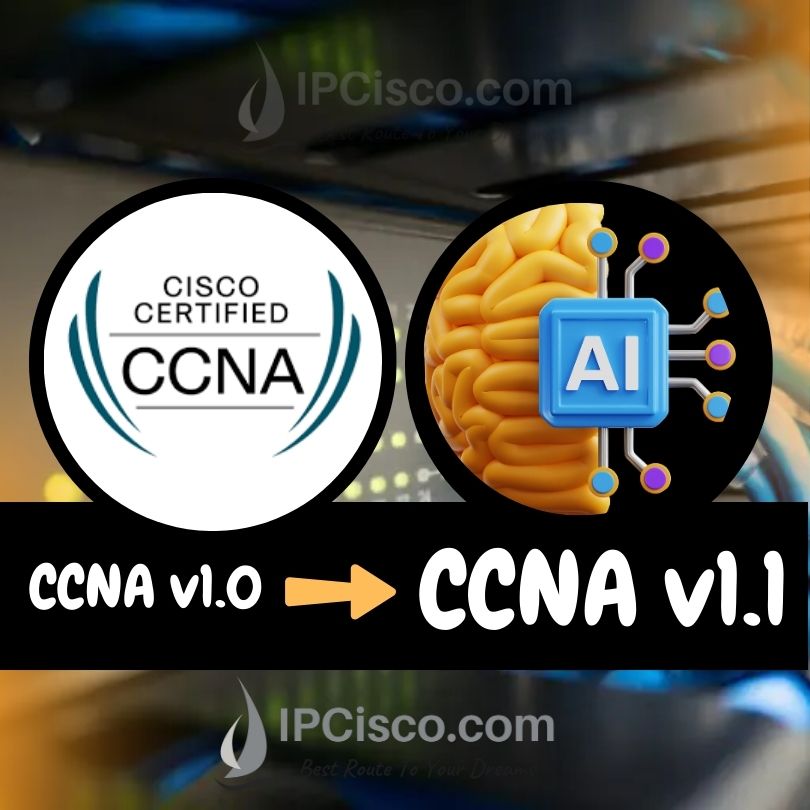
Cisco CCNA v1.1 update, new lessons
In the previous version, basic operations of Rapid PVSTP+ was covered. In new version, all these lessons remain but an additional lesson which has some switching mechanisms is added. These switching mechanisms are Root guard, loop guard, BPDU filter and BPDU guard. This lesson is also covered in CCNP ENCOR Exam.
Instead of “Describe AP and WLC management access” lesson, “Describe network device management access” lesson is added. In this lesson, Cloud managed devices will also be covered.
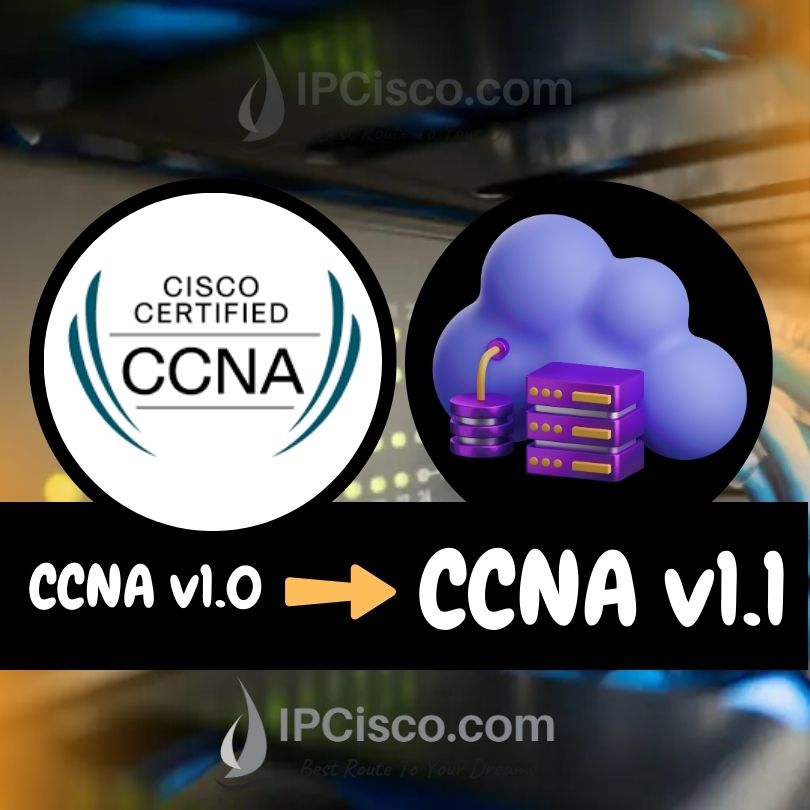
New CCNA v1.1 Lessons: Generative AI, Cloud Network Management, Machine Learning
The lesson named “Compare traditional campus device management with Cisco DNA Center enabled device management” is removed. Instead of this lesson, an artificial intelligence lesson is added. This is “Explain AI (generative and predictive) and machine learning in network operations”.
Another addition is done in “Describe characteristics of REST-based APIs” lesson. Here, “authentication parts” is added.
The latest ccna lessons v1.1 change is about the configuration management mechanism. Here, Puppet and Chef is removed. Instead, Ansible and Terraform are covered. The name of this lesson is “Recognize the capabilities of configuration management mechanisms, such as Ansible and Terraform.”

Cisco CCNA Certification minor update 200-301 v1.1
We Cover All Lessons for CCNA 200-301 v1.1
One of the most known networking blogs, IPCisco also has a CCNA Course. With this course, we cover all the updated lessons of CCNA 200-301 v1.1. We explain each lesson one by one with catchy visuals and at the end of the lesson, with lesson questions, we ask questions to test your knowledge. At the end of the course, if you complete all the lessons successfully, you can print your CCNA course completion certification and you become ready for the official Cisco CCNA 200-301 v1.1 exam.
As always, IPCisco is the best certification study journey for networking professionals, network technicians, network engineers, network administrators, etc. You can view our Cisco CCNA Course here.
What is the last day for CCNA v1.0?
The last day for CCNA v1.0 is 19 August 2024. Till 19 August 2024, you can register for v1.0 exam. After this date, you need to cover new lessons and schedule updated CCNA v1.1.
When can I register for updated CCNA v1.1?
The existing CCNA is CCNA 200-301 v1.0 and it is available till 19 August 2024. This means that minor exam updates go live at 20 August 2024. After 20 August 2024, you can register for updated CCNA 200-301 v1.1. After this date, you can only have CCNA v1.1 and need to cover all the updated lessons.
What if I have already prepared for CCNA v1.0?
Do not worry. Till 19 August 2024, you can take your exam. But if you can not do this till that date, after 20 August 2024, you can learn new lessons and update yourself too. After that, you will be ready to new version. It will not take too much time for you.
Frequently Asked Questions About CCNA Exam
How long does the CCNA exam take?
Exam takes 120 minutes (2 hours).
How many questions are there in CCNA 200-301 v1.1?
There are almost 100 questions in CCNA exam. You will find different type of questions like multiple choice, matching etc.
How long does CCNA exam take to study?
You can finish all the lessons in 3-5 months with a good focus. If you have a good self-paced course, you can finish all these lessons earlier. But it is better to practice more on theorical lessons and practical switch and router configurations.
How can I schedule CCNA 200-301 v1.1 exam?
Cisco website can be used to schedule CCNA 200-301 v1.1 exam.
What is the cost for Cisco CCNA 200-301 Exam?
CCNA certification cost is 300$. You should also pay some tax.
Is there any prerequisite for CCNA 200-301 v1.1?
No. There is no prerequisite for Cisco CCNA. After completing any CCNA course, if you are ready, you can schedule your CCNA Exam and get your certification.
Does IPCisco CCNA Course cover All CCNA v1.1 Lessons?
Exactly! We cover all the updated CCNA v1.1 lessons one by one. We always update our course content according to the certification exam updates.
What percentage of CCNA is updated with v1.1?
Almost %10 of the exam lessons is updated. We have covered all of them in this post.
Updated CCNA Lessons
We have talked about updated lessons in new CCNA 200-301. Now, let’s write down, all the lessons of CCNA 200-301 v1.1. If you have already prepared for previous one CCNA 200-301 v1.0, you can learn the new lessons and have your exam quickly.
1.0 Network Fundamentals (%20)
-
- 1.1 Explain the role and function of network components
- 1.1.a Routers
- 1.1.b Layer 2 and Layer 3 switches
- 1.1.c Next-generation firewalls and IPS
- 1.1.d Access points
- 1.1.e Controllers (Cisco DNA Center and WLC)
- 1.1.f Endpoints
- 1.1.g Servers
- 1.1.h PoE
- 1.2 Describe characteristics of network topology architectures
- 1.2.a Two-tier
- 1.2.b Three-tier
- 1.2.c Spine-leaf
- 1.2.d WAN
- 1.2.e Small office/home office (SOHO)
- 1.2.f On-premise and cloud
- 1.3 Compare physical interface and cabling types
- 1.3.a Single-mode fiber, multimode fiber, copper
- 1.3.b Connections (Ethernet shared media and point-to-point)
- 1.4 Identify interface and cable issues (collisions, errors, mismatch duplex, and/or speed)
- 1.5 Compare TCP to UDP
- 1.6 Configure and verify IPv4 addressing and subnetting
- 1.7 Describe private IPv4 addressing
- 1.8 Configure and verify IPv6 addressing and prefix
- 1.9 Describe IPv6 address types
- 1.9.a Unicast (global, unique local, and link local)
- 1.9.b Anycast
- 1.9.c Multicast
- 1.9.d Modified EUI 64
- 1.10 Verify IP parameters for Client OS (Windows, Mac OS, Linux)
- 1.11 Describe wireless principles
- 1.11.a Nonoverlapping Wi-Fi channels
- 1.11.b SSID
- 1.11.c RF
- 1.11.d Encryption
- 1.12 Explain virtualization fundamentals (server virtualization, containers, and VRFs)
- 1.13 Describe switching concepts
- 1.13.a MAC learning and aging
- 1.13.b Frame switching
- 1.13.c Frame flooding
- 1.13.d MAC address table
- 1.1 Explain the role and function of network components
2.0 Network Access (%20)
-
- 2.1 Configure and verify VLANs (normal range) spanning multiple switches
- 2.1.a Access ports (data and voice)
- 2.1.b Default VLAN
- 2.1.c InterVLAN connectivity
- 2.2 Configure and verify interswitch connectivity
- 2.2.a Trunk ports
- 2.2.b 802.1Q
- 2.2.c Native VLAN
- 2.3 Configure and verify Layer 2 discovery protocols (Cisco Discovery Protocol and LLDP)
- 2.4 Configure and verify (Layer 2/Layer 3) EtherChannel (LACP)
- 2.5 Interpret basic operations of Rapid PVST+ Spanning Tree Protocol
- 2.5.a Root port, root bridge (primary/secondary), and other port names
- 2.5.b Port states (forwarding/blocking)
- 2.5.c PortFast
- 2.5.d Root guard, loop guard, BPDU filter, and BPDU guard
- 2.6 Describe Cisco Wireless Architectures and AP modes
- 2.7 Describe physical infrastructure connections of WLAN components (AP, WLC, access/trunk ports, and LAG)
- 2.8 Describe network device management access (Telnet, SSH, HTTP, HTTPS, console, TACACS+/RADIUS, and cloud managed)
- 2.9 Interpret the wireless LAN GUI configuration for client connectivity, such as WLAN creation, security settings, QoS profiles, and advanced settings
- 2.1 Configure and verify VLANs (normal range) spanning multiple switches
3.0 IP Connectivity (%25)
-
- 3.1 Interpret the components of routing table
- 3.1.a Routing protocol code
- 3.1.b Prefix
- 3.1.c Network mask
- 3.1.d Next hop
- 3.1.e Administrative distance
- 3.1.f Metric
- 3.1.g Gateway of last resort
- 3.2 Determine how a router makes a forwarding decision by default
- 3.2.a Longest prefix match
- 3.2.b Administrative distance
- 3.2.c Routing protocol metric
- 3.3 Configure and verify IPv4 and IPv6 static routing
- 3.3.a Default route
- 3.3.b Network route
- 3.3.c Host route
- 3.3.d Floating static
- 3.4 Configure and verify single area OSPFv2
- 3.4.a Neighbor adjacencies
- 3.4.b Point-to-point
- 3.4.c Broadcast (DR/BDR selection)
- 3.4.d Router ID
- 3.5 Describe the purpose, functions, and concepts of first hop redundancy protocols
- 3.1 Interpret the components of routing table
4.0 IP Services (%10)
-
- 4.1 Configure and verify inside source NAT using static and pools
- 4.2 Configure and verify NTP operating in a client and server mode
- 4.3 Explain the role of DHCP and DNS within the network
- 4.4 Explain the function of SNMP in network operations
- 4.5 Describe the use of syslog features including facilities and levels
- 4.6 Configure and verify DHCP client and relay
- 4.7 Explain the forwarding per-hop behavior (PHB) for QoS, such as classification, marking, queuing, congestion, policing, and shaping
- 4.8 Configure network devices for remote access using SSH
- 4.9 Describe the capabilities and functions of TFTP/FTP in the network
5.0 Security Fundamentals (%15)
-
- 5.1 Define key security concepts (threats, vulnerabilities, exploits, and mitigation techniques)
- 5.2 Describe security program elements (user awareness, training, and physical access control)
- 5.3 Configure and verify device access control using local passwords
- 5.4 Describe security password policies elements, such as management, complexity, and password alternatives (multifactor authentication, certificates, and biometrics)
- 5.5. Describe IPsec remote access and site-to-site VPNs
- 5.6 Configure and verify access control lists
- 5.7 Configure and verify Layer 2 security features (DHCP snooping, dynamic ARP inspection, and port security)
- 5.8 Compare authentication, authorization, and accounting concepts
- 5.9 Describe wireless security protocols (WPA, WPA2, and WPA3)
- 5.10 Configure and verify WLAN within the GUI using WPA2 PSK
6.0 Automation and Programmability (%10)
-
- 6.1 Explain how automation impacts network management
- 6.2 Compare traditional networks with controller-based networking
- 6.3 Describe controller-based, software defined architecture (overlay, underlay, and fabric)
- 6.3.a Separation of control plane and data plane
- 6.3.b Northbound and Southbound APIs
- 6.4 Explain AI (generative and predictive) and machine learning in network operations
- 6.5 Describe characteristics of REST-based APIs (authentication types, CRUD, HTTP verbs, and data encoding)
- 6.6 Recognize the capabilities of configuration management mechanisms, such as Ansible and Terraform
- 6.7 Recognize components of JSON-encoded data
Important pages for Cisco CCNA Certification Studies:
- CCNA 200-301 v1.1 Course
- CCNA 200-301 v1.1 Practice Tests
- CCNA v1.1 FlashCard Questions & Answers
- Updated CCNA v1.1 Labs & Configurations
- Subnet Cheat Sheet For Subnetting Calculations
- Cisco Configuration Lessons on Cisco Packet Tracer
- Cisco Packet Tracer CCNA Router & Switch Configuration Files
Sample CCNA Lessons
- Private IP Address Ranges
- What is a MAC Address?
- What is Local Area Network?
- IP Subnetting Examples
- IPv6 Overview and IPv6 Examples
- Cisco VLAN Configuration on Packet Tracer
- Cisco DHCP Configuration on Cisco Packet Tracer



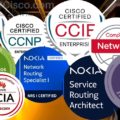
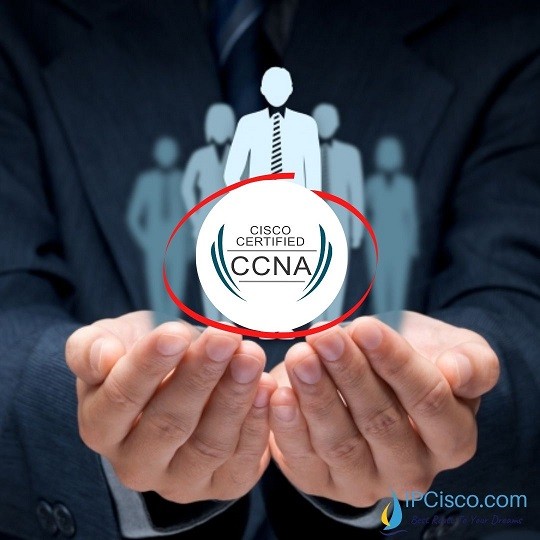
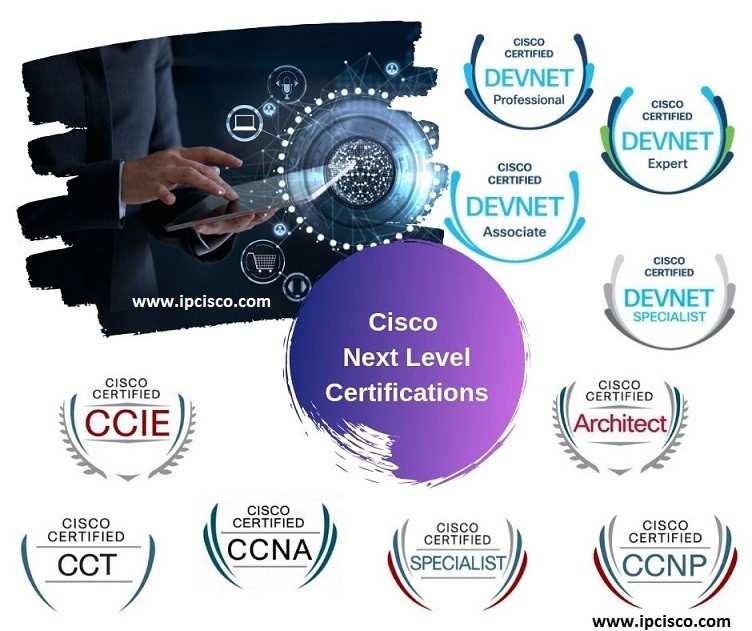

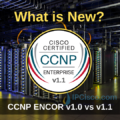

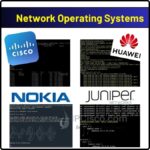
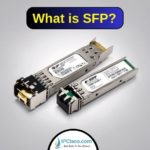
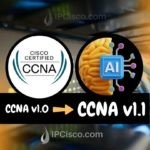

Leave a Reply